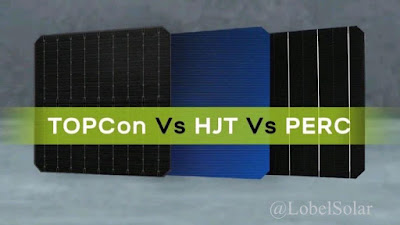👉💥About PERC Technology :
PERC stands for Passivated Emitter & Rear Cell. The PERC solar cell has a presence of a passivation layer at the back side of the cell which helps to minimize recombination losses and increase light absorption.
The key role of the rear-side passivation layer is to reflect light that passes through the silicon cell without being absorbed back into the silicon. By reflecting this light, the passivation layer gives the solar cell second chance at absorbing it & this resulting in significant improvement in efficiency.
👉💥About TOPCon Technology :
The TOPCon solar cell structure consists of a thin tunnel oxide layer sandwiched between a transparent conductive oxide (Tco) layer and a p-doped crystalline silicon layer. The TCO layer acts as a front contact for the solar cell, while the p-doped layer acts as the absorber layer. The tunnel oxide layer acts as a passivation layer, preventing the recombination of charge carriers at the surface of the solar cell. Increased efficiency enables the solar panel to capture a greater amount of energy per unit area.
👉💥About HJT Solar module Technology :
Heterojunction solar panels are a type of photovoltaic panel that consists of three layers of photovoltaic material. These panels incorporate two distinct technologies: crystalline silicon and amorphous (thin-film) silicon, which work in harmony to produce electricity.
HJT cells consist of three main materials: Crystalline Silicon (c-Si), Amorphous Silicon (a-Si) and Indium Tin Oxide (ITO).
The first layer made of amorphous silicon, captures sunlight before it reaches the crystalline layer, as well as any light that reflects off the underlying layers.
The middle layer is composed of monocrystalline silicon, which is primarily responsible for converting most of the sunlight into electricity.
The final layer is another amorphous thin-film silicon layer, located behind the crystalline silicon, which captures any remaining photons that have passed through the first two layers.
By combining these two technologies, heterojunction solar panels can generate more energy than either technology could produce independently. These panels can achieve efficiencies of 25% or higher making them an attractive choice for solar energy generation.

.jpeg)

Comments
Post a Comment
https://lobelpower.com/
HOTLINE NO 9998931555